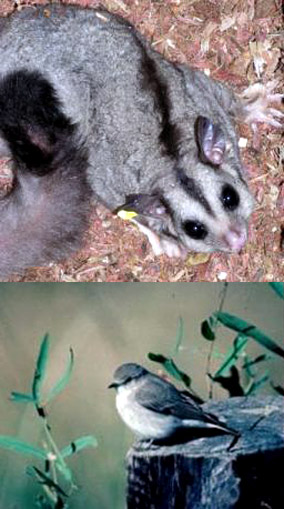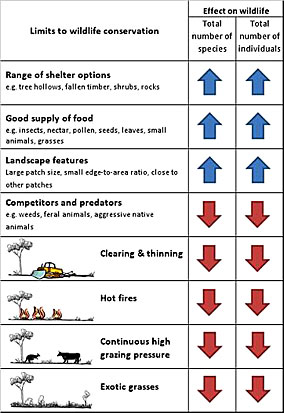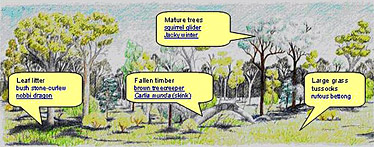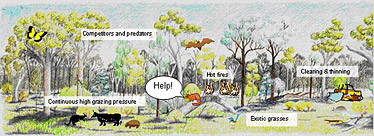Wildlife

Potential to conserve wildlife
Eucalypt woodlands in Queensland support many different types of native plants and animals—including at least 124 threatened or priority species—so restoring eucalypt woodlands has great potential for conserving wildlife.


Native species that occur in eucalypt woodlands include the:
- squirrel glider
- brown treecreeper
- grey-crowned babbler
- squatter pigeon
- jacky winter
- red goshawk
- northern hairy nosed wombat.
Plant species include Bailey's cypress, the shrub Capparis humistrata, the grass Homopholis belsonii, and the herbs Rhaponticum australe and Trioncinia patens.
Many small to medium sized mammals, as well as some birds such as the Paradise Parrot, have seriously declined in numbers or been lost from Queensland's woodland landscapes.
Limits to wildlife conservation


Most actions that will accumulate carbon in cleared eucalypt woodland country (such as not clearing regenerating trees, stopping hot fires, and reducing grazing pressure) will also benefit wildlife by reducing threats.
Different types of shelter for wildlife, a good (and varied) supply of food, the removal (or control) of weeds and feral animals and the size and shape of habitat patches and their distance from each other, will help conserve wildlife in eucalypt woodlands.
Habitat for wildlife
Shelter and food
| Feature | Benefits for wildlife | Used by |
|---|---|---|
| Trees and shrubs |
Nesting, shelter and feeding sites
A diversity of tree and shrub species that flower and fruit at different times can provide a continuous food supply (nectar, pollen, fruit and insects) for animals Dense understorey shrubs can discourage aggressive noisy miners and yellow-throated miners, which may exclude small birds Some animal species need trees and shrubs of a certain size or age (e.g. saplings or dead, standing trees) | Birds, invertebrates, mammals, reptiles, frogs, parasitic plants (e.g. mistletoe) |
| Tree hollows | Shelter, nesting, a place to find food | Parrots, treecreepers, bats, gliders |
| Fallen timber | Shelter, basking and feeding areas | Birds, reptiles, frogs, mammals, invertebrates |
| Large grass tussocks | Food and shelter | Animals and grazing-sensitive plant species |
| Leaf litter | Shelter and feeding areas | Birds, invertebrates, reptiles, frogs, mammals |
| Rocks | Shelter, basking and feedings areas | Invertebrates, reptiles, frogs, mammals, plants |
| Mistletoe |
Nectar, berries and nesting sites
Can provide nectar and berries at times when these foods are scarce in the landscape | Birds, invertebrates, mammals |
| Invertebrates | Food, pollination, seed dispersal | Birds, reptiles, frogs, mammals, plants |
| Fungi | Food, beneficial relationship with plants | Mammals, invertebrates |
Landscape features
| Feature | Benefits for wildlife |
|---|---|
| Large patch size |
Support larger populations of plants and animals
Support animals that need large territories and/or occur in low population densities May also support more species of wildlife |
| Small edge-to-area ratio |
Patches that are rounded in shape suffer fewer 'edge effects' than patches of a similar size that are long and thin
Edge effects include increased weed invasion, predation, wind, sun and temperature, and all of these can have important impacts on wildlife |
| Close to other patches |
Allows animals and plants to disperse between patches
Reduces the risk of predation for animals when they move between patches Improves the exchange of pollen between patches |
| How much of the landscape is cleared |
Birds and mammals are negatively affected if more than 70% of the landscape is cleared of suitable habitat
There is also an interaction between grazing and how much of the landscape is cleared, as cattle tend to congregate in the remaining patches of woody vegetation If most of a landscape, or vegetation type, has been cleared, this also means that any remnants are very important for wildlife conservation, even if they are small or in poor condition. These remnants may provide valuable source populations for restoring other parts of the landscape. |
Habitat features used by some species that live in eucalypt woodlands
| Tree hollows, cracks and crevices | Fallen timber | Trees & shrubs | Large grass tussocks | Litter | Open ground | Mistletoe | Rocks | Insects | |
|---|---|---|---|---|---|---|---|---|---|
| Mammals | |||||||||
| Squirrel glider | x | x | x | ||||||
| Rufous bettong | x | x | x | x | |||||
| Delicate mouse | x | x | x | x | |||||
| Gould's wattled bat | x | x | |||||||
| Birds | |||||||||
| Variegated fairy-wren | x | x | x | x | |||||
| Grey-crowned babbler | x | x | x | x | |||||
| Brown treecreeper | x | x | x | x | |||||
| Rufous whistler | x | x | x | x | x | ||||
| Bush stone-curlew | x | x | x | x | |||||
| Mistletoebird | x | x | x | ||||||
| Reptiles | |||||||||
| Skink | x | x | x | x | |||||
| Marbled velvet gecko | x | x | x | x | |||||
| Nobi dragon | x | x | x | x | x | x | |||
| Plants | x | x | x | x | x |


Threats to wildlife
| Threat | Impacts on wildlife | Wildlife affected |
|---|---|---|
| Weeds and feral animals |
Competition, predation Some management actions to control weeds and feral animals can also have negative impacts on native species | Many different types of plants and animals |
| Exotic grasses |
Replace native plant species
Changes in habitat structure Increased intensity and frequency of fire | Plants, birds, reptiles, mammals |
| Noisy miners and yellow-throated miners | These are aggressive native bird species that reduce the abundance and species richness of small woodland birds | Small birds |
| Grazing pressure |
Modifies the structure of eucalypt woodlands by removing shrubs, inhibiting the establishment of tree seedlings, trampling and browsing saplings, uneven grazing of the grass layer, and producing a short uniform stretch of grass when grazing is heavy.
Grazing appears to benefit some common, widespread plant and animal species, but leads to declines in other species | Many different types of plants and animals |
| Clearing and thinning |
Clearing removes many plant and animal species and also removes the food and shelter of animals that depend on the plant species and structure found in mature woodlands.
Tree thinning appears to benefit some common, widespread bird species, but leads to declines in other species | Many different types of plants and animals |
| Fire | Hot fires may destroy fire-sensitive vegetation; food resources for animals; simplify vegetation structure; and burn relatively large areas, which can disadvantage animals that rely on patchy habitats, or a combination of burnt and unburnt habitats.
Even low severity management fires can remove habitat such as large hollow-bearing trees, which provide essential resources for many animals. Changes in fire regimes (e.g. the season, frequency and intensity of burns) since European settlement may have contributed to the decline of many native species | Many different types of plants and animals |


